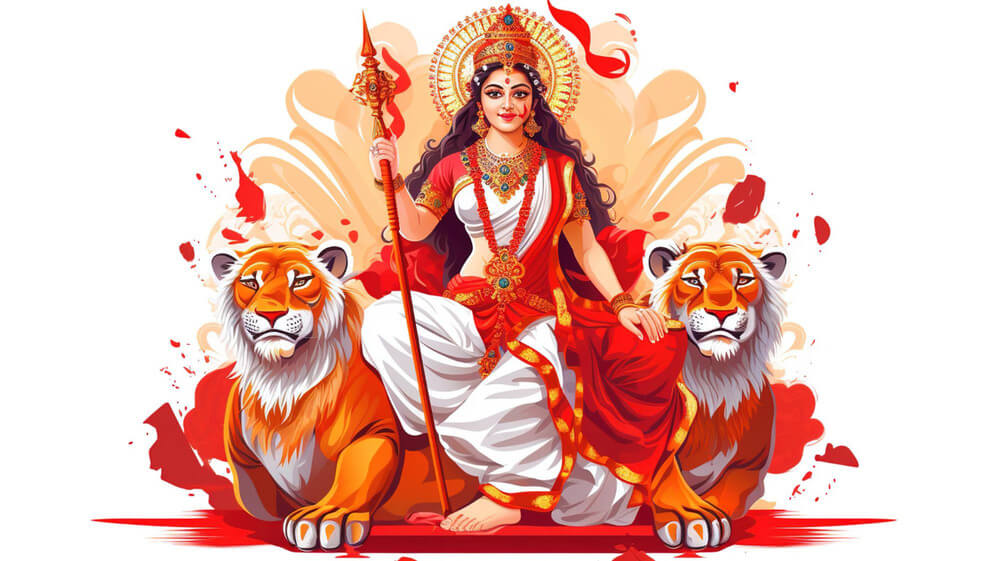Yogmaya: Understanding the Divine Feminine Force
Hindu mythology teems with powerful and multifaceted deities, yet Yogmaya holds a unique place as the
embodiment of divine illusion and the boundless power of Shakti. As the sister of Lord Krishna and the orchestrator of cosmic play, Yogmaya weaves a web of reality that simultaneously obscures the ultimate truth and provides the path to its revelation. In this exploration, we’ll illuminate the nature of Yogmaya and her profound significance within the Hindu spiritual landscape.
Who is Yogmaya?
Sister of Lord Krishna
Yogmaya’s most well-known role is interwoven with the birth narrative of Lord Krishna. Born to Devaki and Vasudeva, she was destined to be exchanged with the newborn Krishna to protect him from the wrath of his uncle, Kamsa. While Kamsa sought to slay the prophesied child who would bring about his downfall, Yogmaya ensured Krishna’s safety.
Divine Illusion (Maya)
Beyond this specific act, Yogmaya is the personification of Maya, the cosmic illusion that veils the true nature of existence. It is through her influence that individuals become engrossed in the material world, mistaking the transient for the eternal. Maya is neither wholly good nor evil; it serves as both a source of attachment and suffering, as well as an impetus for spiritual growth.
Power of Shakti
Yogmaya represents the raw, potent energy of Shakti, the supreme feminine force that animates the universe. Shakti is the creative impulse, the source of manifestation, and the dynamic complement to the static consciousness of Shiva. Yogmaya embodies both the creative and transformative aspects of Shakti.
Yogmaya, Creation, and the Play of Consciousness
The Cosmic Play (Lila)
Yogmaya’s power of illusion lies at the heart of the cosmic play (Lila) of creation. The interplay between Maya and pure consciousness (Brahman) gives rise to the multifaceted universe. This concept emphasizes the illusory nature of separateness; ultimately, all existence emanates from and returns to the one, undivided source.
Spiritual Liberation
Despite facilitating the cycle of creation and the individual’s identification with the material world, Yogmaya also provides the means for spiritual liberation. The veil of Maya, while seemingly formidable, becomes an opportunity for self-transformation. By recognizing the impermanence and illusory nature of material reality, individuals can strive to transcend the limitations of the ego and realize their true, divine nature.
Significance of Yogmaya in Hinduism
Celebration of the Feminine
Yogmaya, as an embodiment of Shakti, underscores the veneration of the divine feminine principle within Hinduism. She represents the vital, creative, and nurturing aspects of the universe, highlighting the balance and integration of masculine and feminine energies within the divine.
Spiritual Practices
Many yogic and devotional practices center around invoking Yogmaya’s grace to pierce the veil of Maya. From the stillness of meditation to the heartfelt devotion of Bhakti Yoga, various spiritual paths offer methods to transcend illusion and unveil the ultimate truth.
Metaphysical Understanding
The concept of Yogmaya enriches the Hindu understanding of reality and encourages profound philosophical inquiry. It asks individuals to question the nature of their perceptions, the limits of the material world, and the boundless potential of spiritual awakening.
Yoga, Meditation, and Unveiling Yogmaya
Yogic Practices
The disciplines of yoga provide a systematic framework for unraveling the illusions created by Yogmaya. Practices like asana (physical postures), pranayama (breath control), and meditation help quiet the fluctuations of the mind and reveal the underlying stillness and clarity of consciousness.
Devotion (Bhakti)
Devotional paths centered on (Devi), the mother goddess in her numerous forms, including Yogmaya, can awaken deep love and surrender. This heartfelt devotion can dissolve the boundaries of ego and open the individual to experiences of unity and transcendence.
Self-Inquiry (Atma Vichara)
The path of self-inquiry invites individuals to question the very nature of their identity. Practices like “Who am I?” meditation encourage a deep exploration of the self, peeling back the layers of illusion to reveal the unchanging consciousness within.
Yogmaya in Hindu Mythology and Literature
Devi Mahatmyam
The Devi Mahatmyam, a central text within the Shakta tradition of Hinduism, exalts the Goddess in her various forms, including Yogmaya. She is depicted as both the benevolent protector of devotees and the vanquisher of demonic forces representing ignorance and ego.
Bhagavata Purana
The Bhagavata Purana narrates Krishna’s life and his numerous divine exploits. Yogmaya plays a role in preserving Krishna’s safety and facilitating his acts of Lila, the divine play.
Yogmaya and Contemporary Relevance
While rooted in ancient mythology, the concept of Yogmaya holds meaning in the modern world:
Psychology and Self-awareness
Yogmaya provides a framework for understanding how our perceptions and attachments shape our experience of reality. It invites introspection and awareness of the mental patterns that keep us bound to limited perceptions of ourselves and the world.
Overcoming Suffering
The understanding of Maya offers solace amidst life’s inevitable challenges. Realizing the transient nature of worldly successes and failures can encourage equanimity and a shift in focus towards more enduring sources of well-being.
Appreciation of Mystery
Yogmaya reminds us of the vastness of existence and the inherent limitations of human understanding. This cultivates a sense of awe, reverence, and a humble acceptance of the unfathomable depths of the universe.
Conclusion
Yogmaya, the enigmatic weaver of illusion and manifestation, occupies a profound space within Hindu philosophy and spiritual practice. Her complex nature mirrors the inherent paradox of existence – the interplay of the ephemeral and the eternal. By understanding Yogmaya’s influence, we open ourselves to the possibility of transcending Maya, embracing the divine feminine, and delving into the heart of our own being.



